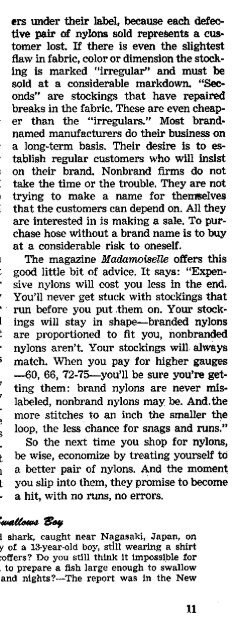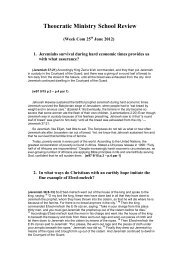- Page 1: GAMBLING-DOES IT SQUARE WITH CHRIST
- Page 16: HAVING @! r TROUBLE WITH t// NYLONS
- Page 24: By " aw~kar"Qc0rrarprrrrdant la Jam
- Page 46: 53 THE PARSIS, followers of zoroast
- Page 56: The McCarthy Censure @ Senator Jose
- Page 60: e emarced till it overpowem temptat
- Page 66: THE MISSION OF THIS JOURNAL Nsws so
- Page 72:
sins to a Priest, in order to obtai
- Page 76:
saved, you and your household," Not
- Page 82:
cient for two furnace&' The smeltin
- Page 94:
of the caretakers of Capototta were
- Page 100:
sufferem d w s disease or leprosy l
- Page 106:
ody of carehlly chosen shape and si
- Page 114:
Chrbtiarz'n Relathhip to Mosaic Law
- Page 118:
calling on the old man at his cabin
- Page 122:
vote of 34 to 14 the U.N. de- cfded
- Page 126:
hot ifi it? hy is it pmclcrim~d? ou
- Page 136:
RUTH has never been pop- ular in th
- Page 148:
pounds without breaking. A firehose
- Page 156:
-whether modem educators think so o
- Page 162:
the command to stop he must dmg lik
- Page 176:
What Is Free? T TAKES money to buil
- Page 188:
nine rockets, reached a m rd land s
- Page 194:
THE MISSION OF THIS JOURNAL News ew
- Page 198:
garded as divine. It waa the embrac
- Page 202:
disciples, "stop becoming sad-faced
- Page 206:
Chdatiun Attitude Tocarrrd Len# In
- Page 210:
in a long crevice. meir long feeler
- Page 216:
ADING-a Dying Art? Nd d Y , they we
- Page 220:
program that is not ready, not the
- Page 224:
T for China's 400 Million By "Awake
- Page 228:
is the wdeh bu&e$ of the bean-curd
- Page 234:
certain number of games (usually ab
- Page 242:
The inspired apostle Paul showed th
- Page 246:
complain about the many tiny roache
- Page 258:
THE MISSION OF THIS JOURNAL 4LAw&l'
- Page 262:
Constructive thlnWng L more than da
- Page 266:
name of God and Christ this gesture
- Page 270:
are twenty. As for divorce, one aut
- Page 274:
trying to chase it into their homes
- Page 278:
New Glw Era Begins Rememk when you
- Page 282:
factions of the party. Generally th
- Page 290:
insects try to perfarm that feat. T
- Page 298:
deaths from all causes are 75 per c
- Page 306:
man life shall be taken in harmony
- Page 310:
ceive their first taste of the refr
- Page 314:
Atmnh -0rEStlon m + January 17 mark
- Page 318:
WAT CHTOWEL SheepIike persons refer
- Page 330:
important tasks of the cultural rev
- Page 334:
though outlawed or imprisoned, ceas
- Page 342:
Respect for Religious Scrupks Rewar
- Page 346:
armed might that thepnce so ferocio
- Page 350:
war, being the crime that it is, do
- Page 356:
Tk MW QUO to Be M o k r t ~ It is a
- Page 360:
M "NO mechanic, however Ingenious,
- Page 368:
Have Done? N THE London Times a cas
- Page 380:
mile arwr with a Mhal radio. active
- Page 394:
merly living cannot g~ beyond 20,00
- Page 402:
dlImnt weapons, dm* strategkl, &- m
- Page 406:
that 52 p r cent of those voting we
- Page 412:
delphia, a litth mth of Chicago and
- Page 418:
COTTON BOWL, DALLAS, TEXAS July 13-
- Page 426:
quiet while yw teach those who can
- Page 432:
histories of thelr symbols and dcmr
- Page 442:
BMa6*eQ#tior*~t 26 Cornet 11's and
- Page 450:
THE MISSION OF THIS JOURNAL ~Awakcl
- Page 454:
truly free or is jE "in process of
- Page 460:
changed thinking m ess from that of
- Page 464:
Bear in m M Paul's words: "This, th
- Page 468:
mer coImh&im of the young that he h
- Page 478:
dl* ANY peopie measure an earthquak
- Page 488:
KEEPllYQ THE t XE most beautiful an
- Page 500:
Twenty-fourth Graduating Class of t
- Page 528:
eighteen kt from the front, whereas
- Page 532:
for off-street parking, as a condit
- Page 538:
pane windw. If storm windows or dou
- Page 592:
q4egt8!!kY*3 7ktou9k Ry "Awd.1" cor
- Page 622:
Epicurean Argument . . HE ancient G
- Page 640:
HAS SCIENCE FREED OR ENSLAVED MANKI
- Page 646:
mass-production industries, establi
- Page 652:
The ffeuW;tgie Hme&r The inventions
- Page 656:
lowed to make. Senit was playG on a
- Page 660:
Dmim8 and Phgiug Card& cards in fou
- Page 668:
let junior off on a happy-go-lucky
- Page 676:
An English expert on arch-re. S. Go
- Page 680:
E W persons realize what a prominen
- Page 686:
example, the custom of knocking on
- Page 696:
Background to South VIetnam Fightin
- Page 700:
it a weak tremor b felt. The tremor
- Page 704:
JEHOVAH'S WITNESSES RECOGNIZED AS C
- Page 708:
VOlJWe XXXVl "NOW it is high time f
- Page 712:
wars between the powew of good ahd
- Page 716:
marPied and waa given a dependency
- Page 720:
7 WO witnesses of Jehovah were prea
- Page 726:
"Q U-A rocked again: 7 killed. Heav
- Page 734:
Scientific management thus joined t
- Page 738:
alpine views. Then, m nhg north fro
- Page 742:
HAT *bought comes to your mind at t
- Page 746:
game: What degree of pleasure and p
- Page 750:
that Lot was Abraham's nephew, well
- Page 754:
for resorting to $he Scriptures dai
- Page 758:
of this has ken stopped as a result
- Page 762:
planes. Still there was Iittle rejo
- Page 766:
It is a pleasure for Jehovah's wihe
- Page 774:
trans of jmpovdshed coal miners, as
- Page 782:
3f as possesing power to think, int
- Page 788:
mediate and conate, alre8dy the m M
- Page 802:
place, a Klngdom Hall, on some prop
- Page 810:
chroni~ effects of oogtfnued ma& ex
- Page 846:
tures. Acute exposures, from 100 to
- Page 858:
L u w State Qnzrch, although the va
- Page 864:
eratic skate Itlie Cttn~ada~'' Uar!
- Page 870:
We Vlritd Hawali'r Volcanic Eruptio
- Page 878:
HE Paulist Press refers to the Bibl
- Page 884:
at frontfer stations, when, registe
- Page 890:
ar.d 9. The bneflts of vaccine "Par
- Page 894:
may be likened to a pen and the Bib
- Page 904:
cmld mvel to Rome and present polit
- Page 968:
growers tend to destroy or hoard su
- Page 974:
ly "Awok~l" rerr.wnd.nt In Moxka IT
- Page 978:
the fourth is from the United State
- Page 982:
HEN the United States icebreaker At
- Page 994:
hsustlble amount of patience. It sh
- Page 998:
URING recent years two totally diff
- Page 1006:
h Palee for that matter, to have di
- Page 1012:
critical. Is there any wonder, then
- Page 1042:
made by thousands in attendance? th
- Page 1088:
THE BIBLE'S RESURRECTION HOPE 'lf a
- Page 1092:
-Ramam 1a:ll Volume XXXVl B,rooklyn
- Page 1108:
tive. A victim of world tensJon, Aw
- Page 1114:
the Bible nor the Talmud qmks of sp
- Page 1118:
Making Rejiglow History In Africa 4
- Page 1122:
Umg, went rhm mbling cod. Like a ga
- Page 1130:
topadfyMmand~Mshwrtuwd the one dtmt
- Page 1136:
- AN you define "conscience"? Do ya
- Page 1140:
N THE map Haiti harthe appearance 0
- Page 1144:
HE book of life is not a literal bo
- Page 1154:
THE MISsION OF THIS JOURNAL Ncwr rw
- Page 1160:
dwindle to the value of just 6ne so
- Page 1164:
8- more joy than m y other course t
- Page 1168:
HE sun has always represented an in
- Page 1172:
Union's Hellotechnicat Laboratmy at
- Page 1178:
x many of the human family left, fo
- Page 1182:
% c; Interested irr I Ip:. 'cr . --
- Page 1214:
Every ,naga.ine has its rirrion. So
- Page 1234:
the kid spoken of in God's Word the
- Page 1242:
and the kangaroo rat are not wdh bo
- Page 1250:
glorified prostimion in the name of
- Page 1256:
HALLOWEEN VANDALISM N THF, United S
- Page 1260:
1ibIe.adults would blame it on "spo
- Page 1264:
' "Acts of'God" . !, . . . I ? , %.
- Page 1268:
Ceylon EYLUN is an island just sout
- Page 1272:
The Uermans Uo to Moscow 9 One day
- Page 1276:
merits can be made. That the Swiet
- Page 1282:
THE MISSION OF THIS JOURNAL News so
- Page 1286:
in today's religions? Many of today
- Page 1290:
Robert Worth Frank of Chicago, Spok
- Page 1294:
therefore are too dten satisfied wi
- Page 1298:
echoed those very wo& lasf December
- Page 1304:
, By "Awaka!" corrsrpondent In Braz
- Page 1308:
By four o'clock, when the dnaI prom
- Page 1316:
In 1547 Henry died, His personality
- Page 1320:
city of Rangoon, , ought at great'
- Page 1326:
NCIENT manuscripts and hieroglyphic
- Page 1336:
The Downfall of a Dictator @ For th
- Page 1340:
een driven to Fitzsirnmons sage fro
- Page 1348:
--lo- 1S:ll Volume XXXVI Brooklyn,
- Page 1354:
the truth that the world possesses
- Page 1358:
literally famished for the Word of
- Page 1364:
federation of Labor) and the worker
- Page 1368:
The Plight of a State Church HERE i
- Page 1372:
As a result of this struggle betwee
- Page 1380:
tainments beer was served to his gu
- Page 1384:
N ANCIENT Greece a master losophy a
- Page 1388:
for! Zeus is the sky, Hera the air,
- Page 1394:
committing suicide, not discarding
- Page 1398:
witnesses not desired." These were
- Page 1402:
(3) the enhancing of Soviet prestig
- Page 1406:
TRANSITORY AS THE SHADOW ON THE DIA
- Page 1416:
THm SOURCE 9 fj, FREEDOM "' 'd true
- Page 1420:
and a remvmy of sight to the blind,
- Page 1426:
The S&W Rmldbm Yet what made the co
- Page 1430:
TMs brings us to scientilfic revela
- Page 1434:
wnws their love and affection that
- Page 1442:
The seedcs are m t in each fruit ad
- Page 1456:
. Similarities of Stoicism 1- - .Y-
- Page 1460:
Salvador OZLY nestled withSn the tr
- Page 1464:
To CiWk Moscow'd Expattsion @ Masco
- Page 1468:
2,000-Year-oia Tomb Found @ The exi
- Page 1474:
THE MISSION OF THIS JOURNAL News uw
- Page 1478:
ut are not admitted to membership i
- Page 1488:
Already dunlng the mmlb of Septemhr
- Page 1492:
E~ew#m Report What follows fs the e
- Page 1500:
HEFE it was! Spread out before our
- Page 1504:
them in the way of Bible study, gos
- Page 1514:
such instance her deceit was discov
- Page 1518:
authority over a man, but to h in s
- Page 1528:
France,-finding herself fn an embar
- Page 1534:
THEY'RE ANCl ENT HiSTOlRY 1956 YEAR




